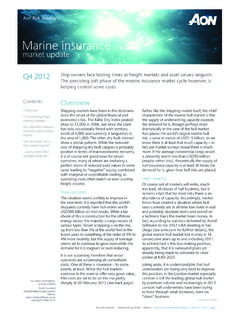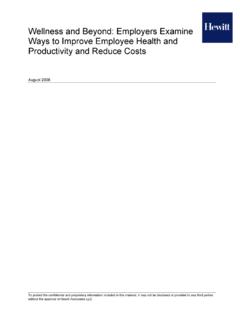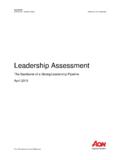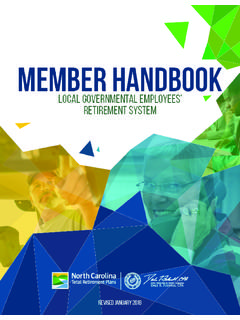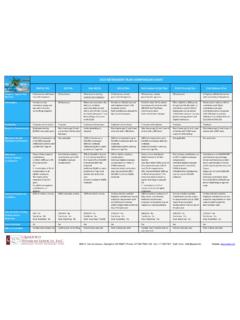Transcription of VOLUME UMBER F JOURNAL of PENSION PLANNING …
1 VOLUME 39, NUMBER 3 JOURNAL ofPENSIONPLANNING &COMPLIANCEE ditor-in-Chief: Bruce J. McNeil, 2013 JPPC The Split Personalities of 457(b) Nonqualified Plans DANIEL SCHWALLIE Daniel Schwallie, JD, PhD is an attorney with Aon Hewitt s Retirement-Legal Consulting & compliance practice. His areas of consulting include the design and administration of qualified PENSION and profit-sharing plans, 403(b) and 401(k) plans, and 457(b) nonqualified deferred compensation plans. He has published articles on plan compliance and is the primary author of the Cash Balance Plan Answer Book , 2nd ed. (New York: Wolters Kluwer, 2012). The same section of the Internal Revenue Code (Code) governs, but very different rules apply to 457(b) plans of tax-exempt organizations and governmental entities. No wonder there is often confusion about these nonqualified deferred compensation plans.
2 Changes made by the Economic Growth and Tax Relief Reconciliation Act of 2001 (EGTRRA) made 457(b) plans more attractive as a retirement savings vehicle for eligible employers. This article provides a detailed overview of the similarities and differences between 457(b) plans of state and local governments and those of tax-exempt organizations (other than governments). 2 / JOURNAL OF PENSION PLANNING & compliance BACKGROUND ON CODE SECTION 457(B) Code 457 describes eligible and ineligible nonqualified plans for eligible employers, , state and local government employers and other (nongovernmental) employers exempt from federal income taxa-tion (tax-exempt employers). 1 Code 457(b) defines the requirements to be an eligible nonqualified plan. A deferred compensation plan of an eligible employer that does not satisfy the requirements of 457(b) is not an eligible plan and is an ineligible plan under Code 457(f ), unless the plan is either a qualified plan under Code 401(a), a 403(b) plan, a qualified governmental excess benefit plan under Code 415(m), the portion of any plan that consists of a transfer of property under Code 83, the portion of any plan that consists of a nonexempt trust under Code 402(b), an applicable employment retention plan under Code 457(f )(4), or certain other arrangements described in regulations.
3 2 There are at least two advantages of a 457(b) plan over a 457(f ) plan. First, a 457(b) plan is not subject to Code 409A, while a 457(f ) plan is. 3 Second, the amounts deferred under a 457(b) plan, whether due to salary reductions or nonelective employer contributions, generally are not taxable until paid to the participant or beneficiary, in the case of a governmental plan, or until paid or otherwise made available to the par-ticipant or beneficiary, in the case of a plan of a tax-exempt employer. 4 Amounts deferred under a 457(f ) plan must be included in income of a participant or beneficiary for the first taxable year in which there is no substantial risk of forfeiture of rights to the deferred compensation. 5 The right of a person to compensation is subject to a substantial risk of forfeiture if the person s right to such compensation is conditioned on the future performance of substantial services by any individual.
4 6 Many of the rules for 457(b) plans are the same for both govern-mental and tax-exempt employers, but many are different. For example, a 457(b) plan for a tax-exempt organization is an unfunded top hat plan under the Employee Retirement Income Security Act of 1974 (ERISA), 7 while a governmental 457(b) plan must be funded by a trust, 8 even though both are nonqualified plans. As will become apparent in this article, governmental 457(b) plans are more like qualified plans than 457(b) plans of tax-exempt employers. THE IMPACT OF EGTRRA ON 457(B) PLANS Prior to EGTRRA and subsequent legislation, 457(b) plans of tax-exempt organizations and governmental entities were more similar than they are today. EGTRRA made 457(b) plans more attractive for both types of eligible employers, but also increased the THE SPLIT PERSONALITIES OF 457(B) NONQUALIFIED PLANS / 3 differences between governmental and tax-exempt employer 457(b) plans.
5 Generally, EGTRRA changes were effective beginning in 2002. 9 For example, prior to EGTRRA, amounts deferred under a 403(b) or 401(k) plan, a simplified employee PENSION plan (SEP) under Code 408(k), a SIMPLE retirement account under Code 408(p), and contri-bution amounts deductible under a plan described in Code 501(c)(18) during a tax year reduced, dollar for dollar, amounts that could be deferred under a 457(b) plan for that tax year. 10 EGTRRA eliminated this coordination and established a separate, and increased, limit for amounts deferred under a 457(b) plan. 11 The basic annual limit on 457(b) compen-sation deferrals was increased to the lesser of 100 percent of compensation (as defined under Code 415(c)(3)) or a dollar amount that is the same as the annual dollar limit on elective deferrals to a 403(b) or 401(k) plan. 12 EGTRRA also eliminated special minimum required distribution require-ments applicable to 457 plans 13 and eliminated the same desk rule, thereafter allowing distributions of elective deferrals following a severance from employment, for 457(b) plans as well as for 403(b) and 401(k) plans.
6 14 EGTRRA extended the direct rollover and withholding rules to distributions from governmental 457(b) plans, including requiring the rollover notice for eligible rollover distributions. 15 EGTRRA also changed when amounts deferred under a governmental plan become includible in income to when paid rather than when paid or other-wise made available. Amounts deferred under a plan of a tax-exempt employer continue to become includible in income when paid or otherwise made available. These changes made 457(b) plans more attractive for deferring compensation and increased the differences between the plans of govern-mental employers and tax-exempt employers. For tax-exempt employ-ers, the repeal of the coordination with 401(k) and 403(b) deferrals and increased 457(b) deferral limits meant more could be deferred under a 457(b) plan, without the taxation upon the first taxable year in which there is no substantial risk of forfeiture of rights to the deferred compen-sation that would exist under a 457(f ) plan.
7 With the exception of certain grandfathered governmental 401(k) plans (adopted by a governmental entity before May 6, 1986), 16 state and local governments cannot spon-sor a 401(k) plan, 17 but state and local public schools (including public colleges and universities) can maintain 403(b) plans, 18 so the repeal of the coordination with 401(k) and 403(b) deferrals still made 457(b) plans more attractive for many public entities, particularly public schools, colleges, and universities. The added ability to make eligible rollover distributions to and from a governmental 457(b) plan and EGTRRA limiting taxation of amounts deferred to when paid further increased the attractiveness of 457(b) plans to many governmental entities. 4 / JOURNAL OF PENSION PLANNING & compliance ELEMENTS COMMON TO 457(B) PLANS OF TAX-EXEMPT AND governmental EMPLOYERS A number of required and permissive provisions of 457(b) apply to all eligible employers, whether they are tax-exempt organizations or state and local governments.
8 Written Plan Document Required A 457(b) plan must be established and maintained by an eli-gible employer pursuant to a written plan document containing all the material terms and conditions for benefits under the plan. 19 Although no prototype plan documents approved by the Department of Treasury (Treasury) and the Internal Revenue Service (IRS) are avail-able, the Treasury and IRS issued model governmental 457(b) plan lan-guage in 2004. 20 However, such model language has not been updated to reflect final 415 regulations issued in 2007 or to reflect subsequent legislative changes affecting 457(b) plans. 21 Salary Reduction Contributions Permitted Amounts can be deferred under a 457(b) plan through salary reduction contributions for any calendar month only if an agreement providing for the deferral is entered into before the first day of the month in which the compensation is paid or made available or, in the case of a new employee, before the first day in the calendar month on which the employee performs services for the eligible employer.
9 The plan may provide that the agreement will remain in effect until the par-ticipant revokes or alters the terms of the agreement. 22 Although the regulations under Code 457 do not expressly require that salary reduction contributions are immediately vested, IRS examination guidelines for 457(b) plans and certain other guidance from the IRS indicate that salary reduction contributions should be immediately vested. 23 Nonelective Employer Contributions Permitted Employer contributions other than on behalf of a participant under a salary reduction agreement ( , nonelective employer contri-butions with respect to which the participant does not have the choice to instead receive the contribution amount in cash or property) are permitted under a 457(b) plan. A nonelective employer contribution to a 457(b) plan includes employer contributions to the plan that are matching contributions on a participant s salary reduction contribu-tions to the 457(b) plan.
10 24 However, contributions to a 457(b) plan that are matching contributions on a participant s elective contributions THE SPLIT PERSONALITIES OF 457(B) NONQUALIFIED PLANS / 5 to a 401(k) or 403(b) plan are not permitted, because of the anti- conditioning (contingent benefit) rules of 401(k) and 403(b). 25 Annual Deferral The amount of compensation deferred under a 457(b) plan for a taxable year, whether by salary reduction or by nonelective employer contribution, is the annual deferral amount for purposes of the limits under 457(b) and otherwise. The amount of compensation deferred under a 457(b) plan is taken into account as an annual deferral in the taxable year of the participant in which deferred or, if later, the year in which the amount of compensation deferred is no longer subject to a substantial risk of forfeiture. 26 If the amount of compensation deferred under the plan during a taxable year is not subject to a substantial risk of forfeiture, the amount taken into account as an annual deferral is not adjusted to reflect gain or loss allocable to the compensation deferred.




